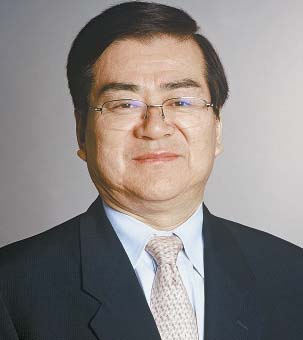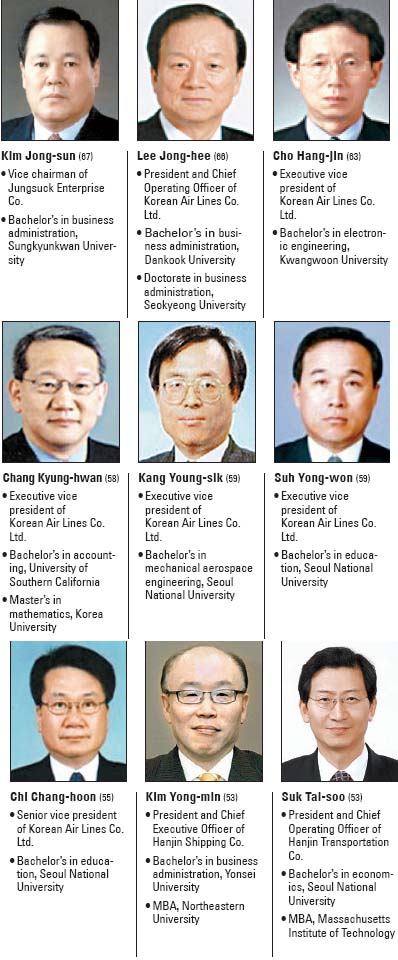Masters of sky, land and sea

Cho Yang-ho (59) Chairman of Hanjin Group, Master’s in business administration, University of Southern California ,Doctorate in business administration.
With Korea’s No. 1 carrier and shipping company as its subsidiaries, the Hanjin Group has been a bridge connecting Korea to the rest of the world.
The logistics group covers all realms of transportation and shipping including land, water and sky with flagship airline Korean Air Lines Co. Ltd., top shipping company Hanjin Shipping as well as Hanjin Transportation, which takes care of land transport. The group presently has 33 subsidiaries including Jungsuck Enterprise Co., Korea Airport Service, KAL Hotel Network and Inha University (famous for its aviation department).

In 1969, the group took a big leap forward by signing Korea’s first containerized shipping business deal with U.S.-based Sealand Co. as well as taking over publicly-owned Korean Airlines and changing it to Korean Air Lines Co. Ltd.
Korean Air was the country’s first airline company. Headquartered in Seoul, the company’s 125 airplanes fly to 116 destinations in 39 countries.
At the center of the group’s evolution is Cho Yang-ho, 59, chairman of the Hanjin Group. He is the eldest son of late Hanjin Group founder and former chairman Cho Choong-hoon, who began Hanjin in Incheon when he was in his 20s. The younger Cho started his career in 1974 at Korean Air.
His achievements include globalizing the company. During the 1990s, when global airline alliances including Star Alliance and Oneworld started taking off, Cho acted quickly and persuaded U.S.-based Delta Airlines and Air France to form an alliance with Korean Air.
In 2000, he made Korean Air one of the founding members of Skyteam. Skyteam includes Delta Airlines, Air France, Aeromexico and KLM Royal Dutch Airlines, among others.
Cho’s right-hand man and Korean Air’s president and chief operating officer, Lee Jong-hee, 66, recalled Cho’s efforts back then.
“The chairman first suggested to Delta, with which he was quite friendly, that they form their own alliance. Delta took his offer saying that Korean Air is one of the representative airline companies in Asia,” Lee said.
Cho has also acted as an unofficial Korean diplomat, such as when the airline sponsored the Louvre Museum’s addition of Korean to its multimedia guide service last February. Korean is the second Asian language added to the system after Japanese.
Cho’s active involvement in Korean Air’s engineering division distinguishes him from other conglomerate owners. He acts less like a tycoon and more like an industry specialist.
Cho even learned to fly small propeller planes, although he didn’t obtain a pilot’s license because of his father’s objections. Besides being chairman of Hanjin Group, he is the chairman and Chief Executive Officer of Korean Air.
Under his leadership, the group in recent years bought fuel-efficient passenger planes including A380s and B787s to cope with the global economic slowdown and higher oil prices. Also in 2007, to ensure a stable fuel supply, it bought a 28.4 percent stake in S-Oil and became its second-biggest shareholder.
The company ventured into the budget carrier industry last July by launching Jin Air, Korean Air’s low-cost airline unit.
President Lee has assisted Cho in passenger services for around 20 years. Lee started his career at Korean Air in 1969 among the first batch of company employees and has headed several divisions including engineering and marketing.
After Lee became president and COO of Korean Air in 2004, the company has steadily been in the black.
Korean Air has four executive vice presidents. With his background in engineering Cho Hang-jin, 63, has participated in the development of F-16s and B787s. He started at the company in 1973 and is known to maintain a fluid communication channel between Korean Air and various supporting organizations.
Another of the airline’s vice presidents and a fellow University of Southern California graduate along with Cho Yang-ho is Chang Kyung-hwan, 58. Chang started at Korean Air in 2003 after serving as president of KPMG-U.S. Partner and KPMG Consulting Korea. He is known in the company as the top marketing strategist and has helped guide it through recent currency and oil problems. He was one of the leaders of the stake purchase in S-Oil.
Kang Young-sik, 59, another Korean Air executive vice president, is noted for leading the airplane maintenance division, whose mission is to reduce flight cancellations due to technical problems. He is also credited with the company’s high safety standards.
Lastly, Korean Air executive vice president Suh Yong-won, 59, is recognized for his accomplishments as head of Korean Air’s employee education and training division.
Chi Chang-hoon, 55, a senior vice president at Korean Air, is noted for leading the expansion of flight service to cities in China during his past tenure as the company’s China regional head.
Key figures at Hanjin’s other subsidiaries include Kim Jong-sun, 67, vice chairman of Jungsuck Enterprise Co., the group’s real estate management unit. Jungsuck became part of Hanjin Group in 1978, after the group’s acquisition of Haeun Center. Kim became part of the group in 1967 and was an executive at Hanjin Transportation for some time. He is also the head of Jungsuck Academies, which offers various aviation courses.
Suk Tai-soo, 53, Hanjin Transportation president and COO, became part of the Hanjin family in 1984 when he became an employee at Korean Air. After having been a high-level executive at Korean Air’s marketing division, he was promoted to lead Hanjin Transportation in January 2008. He led important marketing projects at Korean Air, including the A380 project.
By Cho Jae-eun Staff Reporter [jainnie@joongang.co.kr]










with the Korea JoongAng Daily
To write comments, please log in to one of the accounts.
Standards Board Policy (0/250자)